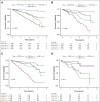Polygenic Breast Cancer Risk for Women Veterans in the Million Veteran Program
- PMID: 34381935
- PMCID: PMC8345920
- DOI: 10.1200/PO.20.00541
Polygenic Breast Cancer Risk for Women Veterans in the Million Veteran Program
Abstract
Accurate breast cancer (BC) risk assessment allows personalized screening and prevention. Prospective validation of prediction models is required before clinical application. Here, we evaluate clinical- and genetic-based BC prediction models in a prospective cohort of women from the Million Veteran Program.
Materials and methods: Clinical BC risk prediction models were validated in combination with a genetic polygenic risk score of 313 (PRS313) single-nucleotide polymorphisms in genetic females without prior BC diagnosis (n = 35,130, mean age 49 years) with 30% non-Hispanic African ancestry (AA). Clinical risk models tested were Breast and Prostate Cancer Cohort Consortium, literature review, and Breast Cancer Risk Assessment Tool, and implemented with or without PRS313. Prediction accuracy and association with incident breast cancer was evaluated with area under the receiver operating characteristic curve (AUC), hazard ratios, and proportion with high absolute lifetime risk.
Results: Three hundred thirty-eight participants developed incident breast cancers with a median follow-up of 3.9 years (2.5 cases/1,000 person-years), with 196 incident cases in women of European ancestry and 112 incident cases in AA women. Individualized Coherent Absolute Risk Estimator-literature review in combination with PRS313 had an AUC of 0.708 (95% CI, 0.659 to 0.758) in women with European or non-African ancestries and 0.625 (0.539 to 0.711) in AA women. Breast Cancer Risk Assessment Tool with PRS313 had an AUC of 0.695 (0.62 to 0.729) in European or non-AA and 0.675 (0.626 to 0.723) in AA women. Incorporation of PRS313 with clinical models improved prediction in European but not in AA women. Models estimated up to 9% of European and 18% of AA women with absolute lifetime risk > 20%.
Conclusion: Clinical and genetic BC risk models predict incident BC in a large prospective multiracial cohort; however, more work is needed to improve genetic risk estimation in AA women.
© 2021 by American Society of Clinical Oncology.
Conflict of interest statement
Paul Spellman Expert Testimony: Natera, Foundation Medicine No other potential conflicts of interest were reported.Paul Spellman Expert Testimony: Natera, Foundation Medicine No other potential conflicts of interest were reported.
Figures



References
-
- Nyström L, Andersson I, Bjurstam N, et al. : Long-term effects of mammography screening: Updated overview of the Swedish randomised trials. Lancet 359:909-919, 2002 - PubMed
-
- Nyström L, Bjurstam N, Jonsson H, et al. : Reduced breast cancer mortality after 20 years of follow-up in the Swedish randomized controlled mammography trials in Malmö, Stockholm, and Göteborg. J Med Screen 24:34-42, 2017 - PubMed
-
- Collaborative Group on Hormonal Factors in Breast Cancer : Familial breast cancer: Collaborative reanalysis of individual data from 52 epidemiological studies including 58 209 women with breast cancer and 101 986 women without the disease. Lancet 358:1389–1399, 2001 - PubMed
-
- Thompson D, Easton D: The genetic epidemiology of breast cancer genes. J Mammary Gland Biol Neoplasia 9:221-236, 2004 - PubMed
Publication types
MeSH terms
Grants and funding
LinkOut - more resources
Full Text Sources
Medical

